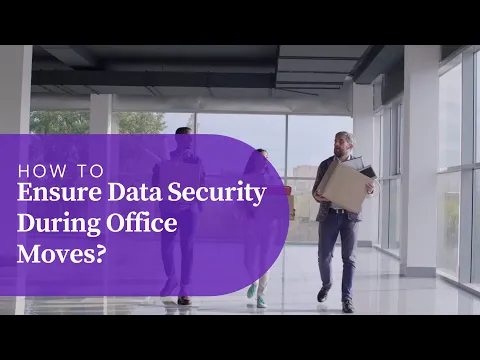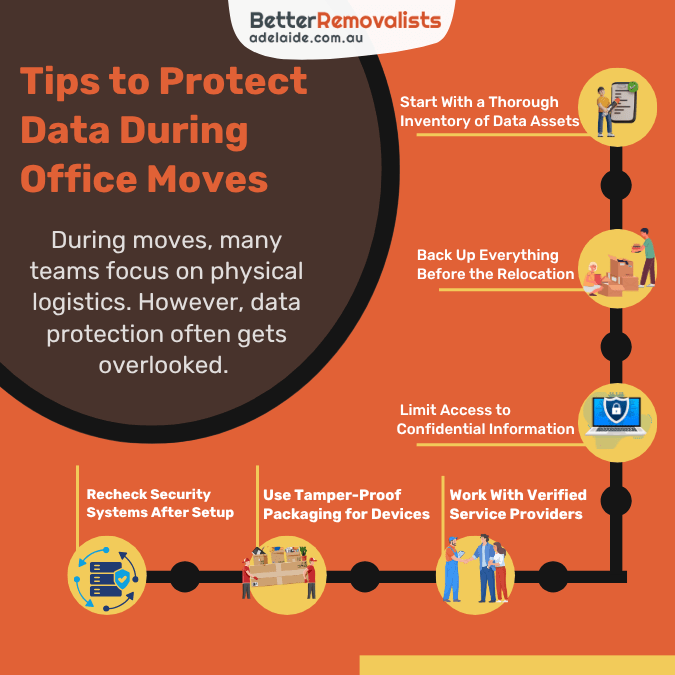


Office relocations involve more than shifting desks and computers. Amidst the excitement of a new workspace, one crucial aspect often overlooked is data security. As technology becomes increasingly intertwined with daily operations, data is an organisation’s most valuable asset. When a company changes location, its sensitive data is also at risk. From hardware theft to file misplacement, the threats are real.
During moves, many teams focus on physical logistics. However, data protection often gets overlooked. Without the right precautions, it could lead to information loss or breaches. A secure relocation plan helps companies avoid unexpected risks. This blog highlights key steps businesses must take to ensure data security. It focuses on practical tips that apply to every workplace, regardless of its size or industry.
Hide
Show
Every office stores some form of confidential data. It may include customer details, financial records, or employee information. The first step is identifying all types of data stored within the company. This includes both digital and physical files. List servers, hard drives, USBs, and cloud accounts. It’s essential to track the location of each asset and identify who has access to it. This helps in planning a safer relocation process. Once the inventory is complete, businesses can create a checklist to use during the move. Files with high sensitivity should be handled more securely during the move. A checklist helps you jot down every detail, including updating the new address, packing office furniture, hiring professional removalists Adelaide, securing credential data, etc.

Before shifting devices or hardware, backing up data is essential. It ensures information is not lost if a system gets damaged or misplaced. Using both physical and cloud based storage is a smart approach. Cloud backups provide easy access and added security. Businesses should also consider encrypting files before storing them. Encryption adds an extra layer of protection against unauthorised access. This business premises step brings peace of mind during office transitions. If a system fails or is stolen, the data remains secure and recoverable.
Not everyone needs access to every piece of data. During a move, the risk of insider threats or mishandling increases. That’s why it’s important to restrict access to sensitive documents. Temporary passwords can be created for shared systems. Only authorised personnel should handle classified files and devices. Staff should also be reminded of basic data security practices. Simple actions, such as locking your computer or avoiding public WiFi, can help. Businesses should treat the moving period as a high alert zone for information security.
Choosing the right moving partner is critical. Businesses must select a reliable team with proven experience in office relocations. For example, working with certified professional Removalists Adelaide can offer extra assurance. These professionals understand how to handle office equipment with care and respect. They adhere to security protocols and maintain accurate documentation. This helps minimise errors and keeps data devices safe throughout the move. Companies should verify licenses, read reviews, and confirm service history. It’s also good to ask about their data handling policies before signing contracts.
All IT equipment must be packed securely during transportation. Using tamper evident seals or coded labels is recommended. This allows the business to track if a package was opened or misplaced. Every box containing data-sensitive hardware should be marked clearly. Teams must also maintain a checklist while loading and unloading. This step reduces the chances of any device getting lost during the move. Hiring professional Adelaide removal experts with packing and moving experience also helps. They ensure all materials are handled with the right care and attention.
When moving, it is beneficial to have one person oversee the securing of data. This person’s responsibility is to oversee the movement of equipment, maintain checklists, and ensure that all equipment functions properly. This person serves as the liaison between the teams and the movers. They track the systems, take note of concerns, and oversee the entire move. This allows the individual to ensure that all safety protocols are followed. In bigger companies, that role can be split between departments. Regular updates and clear communication of the rules and regulations can help bring everyone back on track to achieve the safety goals.
Once the new office becomes fully operational, all data systems must be retested. Firewalls, antivirus software, and access controls should be thoroughly reviewed. The weak points in the new office would need to be scrutinised. It is prudent for businesses to consider resetting passwords or further limiting access. All forms of malware would require IT teams to scan all hardware and software. This end-of-moving check reinforces the confidence that all systems are safe before resuming normal work levels. Engaging with trusted and experienced professional movers who genuinely understand IT safety would make moving easier for the business. It helps protect businesses from technical concerns following the move.

Office relocations necessitate a meticulous approach to securing access to sensitive data. A few wise decisions can make a big difference in preventing mistakes that could endanger security. From data backup to restricted access, every decision is important. Using trusted companies can provide an added layer of security. When preparing to relocate, businesses should plan for a move that is safe for their data.



